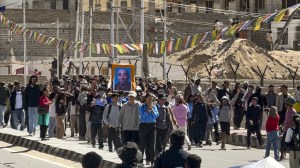Island in the Mainstream
...

Fifteen such villages stood on the windswept, seawashed beach prior to December 26, 2004, studding the island’s coastline like scattered beads on a necklace. Not one survived the tsunami.
Yet, one year after the disaster, this island tribe’s response to the tsunami evokes some kind of awe and inspiration. The community, though split into 15 villages, displays an extraordinary unanimity, a stoic resilience in its moments of crisis as life is rebuilt anew.
The most prominent change in Nicobarese life is the shift inland, a move that snaps a century-long bond with the sea.
‘‘We don’t feel safe any more, living on the seaside. It’s better to be on high ground… one never knows when the sea will strike,’’ says Samuel Edward, the first captain of Kakana village. His relocated village is known as New Kakana.
Most of the Nicobarese used to sail into the seas in dongas for fishing. After the tsunami, no one ventures into the seas anymore; the fishing is done mostly from the shoreline. ‘‘It will take ages before the tribe restores its seafaring nature and rediscovers the confidence to ride the waves. It may have been lost forever,’’ says Edward.
Car Nicobar district collector Vivek Parowal tries to showcase the silent resilience of the tribe as he narrates: ‘‘Not one complaint has been heard till date from a single Nicobarese about relief and rehabilitation. This, despite the fact that relief and rehabilitation have often been tardy and slow because of logistical problems.’’
BUT the tsunami has impacted Nicobarese society in other ways, too. For one, the post-tsunami days exposed the community—probably for the first time—to the much faster and relatively more modern life of Port Blair, where a major chunk of the 20,000-strong population was transported and housed for almost half-a-year. Earlier forays into the archipelago’s headquarters or to the mainland were sporadic and restricted to a select few.
Add to the prolonged exposure to the life at Port Blair the sudden flow of compensation cash. ‘‘We never realised the value of money earlier. Ours is a society that has been traditionally driven by needs. Once the basic requirement is met, a Nicobarese is happy. But there are indications of change now,’’ says George Arthur, a Nicobarese youth.
|
3,513 |
Corroborates Ranjit Singh, the assistant commissioner of Car Nicobar, who has been hands-on in the rebuilding process since January 2005. ‘‘Compensation payments have pumped in well over Rs 50 crore into the Car Nicobar group of islands within a very short span of time. Of this, more than 50 per cent was for Car Nicobar alone,’’ says Singh. ‘‘This has had an immediate impact. More than 400 two-wheelers have come into the islands since the doles began. There is definitely a correlation.’’
THE first Maruti Baleno, too, rolled into the island, post-tsunami. Though owner Great Heart—a Nicobarese junior engineer with the Andaman PWD at Car Nicobar—denies the car had anything to do with the Wave, administration officials say his family collected a huge amount in compensation for tsunami deaths.
S K Nanda, a Maruti car dealer in Port Blair, agrees the list of potential customers in Car Nicobar has suddenly lengthened; service teams are also being sent in more frequently for the clients.
‘‘In an island where bicycles were few and far between, the sudden influx of four- and two-wheelers definitely marks a drastic change,’’ says Ranjit Singh. ‘‘The Nicobarese have suddenly come to realise the value of money.’’
But it’s not the entry of consumerism or even the spike in alcohol demand that worries the older generation of Nicobarese. It is the mainlanders who are making inroads into their society and marrying Nicobarese girls.
Ireena Mark, elected the first lady cptain of Small Laphaty village in 2003, is deeply concerned about the Nicobarese girls who marry outside the community. ‘‘Any mainlander who marries one of us will have to become part of our value system, our society and forget his roots. We have been telling our girls about the danger. But if they don’t listen what can we do? After all, love is supreme and we don’t prevent anyone from dong what she feels right,’’ says Ireena.
EVEN at this moment of crisis, the strongest bond tying the community is the inbuilt social security system. After the tsunami, for example, when NGOs sought to set up orphanages to look after children who had lost their parents, the community was outraged.
‘‘Our community has no concept of an orphan,’’ asserts Thomas Philip, first captain of Mus village and a tribal council member. The community takes charge of a child when his parents cannot and an adoption follows. Thomas Philip himself has five adopted sons and daughters in addition to his own three, all of whom have equal rights over all his property.
Even property can’t be divided and split. The community follows a concept of an extended family structure—tuhet in Nicobaari—which is the supreme body.
In the midst of grief in shattered homes, the Nicobarese seem to find some solace in their tuhet. It is isolation, more than anything else, that the community is searching for to recover from the tsunami wounds.





- 01
- 02
- 03
- 04
- 05


























